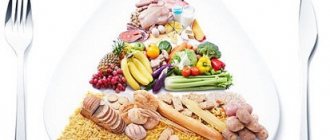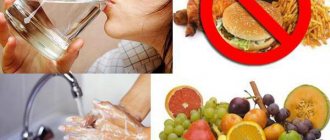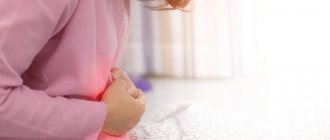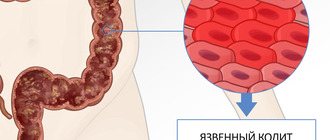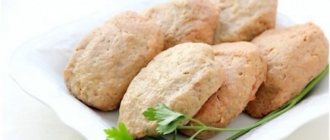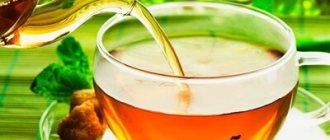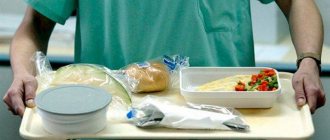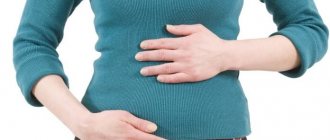Indications for the use of the “basic” dietary table No. 4 are diarrhea of any nature, or more precisely, diseases of an acute or chronic nature that these same diarrhea cause. Prescribing medication for diarrhea is usually not enough. With food we get hundreds of potentially fermenting or rotting substances; if we continue to eat them in large quantities, medicines will not help much. So it’s worth “arming yourself” with table No. 4 both in case of a serious infectious disease and in case of banal food poisoning from stale food.
Table No. 4a Table No. 4b Table No. 4c Table No. 4d
General rules
Let's figure out what a therapeutic diet is.
Nutritional therapy is prescribed for various diseases and is a mandatory method of therapy. In some cases, this is the only or primary method of treatment. The founder of dietetics M.I. Pevzner, who developed the basics of therapeutic nutrition, wrote that in its absence there is no rational treatment. For each disease, a specific table is assigned. Thus, Table No. 4 (Diet No. 4 according to Pevzner) is prescribed for intestinal diseases that occur with diarrhea . The purpose of its administration in this condition is to reduce inflammation, fermentation and putrefactive processes that predominate in this case. It protects the intestines and helps normalize digestion.
Due to the reduction of fats (up to 70 g) and carbohydrates (250 g), it has a reduced energy value. Daily calorie content is 2000 kcal. At the same time, the normal protein content (90 g) is maintained. All kinds of intestinal irritants are significantly limited: mechanical, chemical and thermal.
Products that enhance secretion, fermentation and putrefaction processes, stimulants of bile secretion, secretion of gastric juice and pancreas are excluded. Dishes are boiled or steamed, served in a liquid, semi-liquid or mashed state. Very hot and cold foods are excluded. Salt is allowed in the amount of 8-10 g, the water regime is 1.5-2 liters per day. Meals are provided up to 5-6 times a day, in fractional portions and warm.
The basic rules are:
- six meals a day, the basis of which are mashed, pureed, mushy dishes, slimy soups;
- boiled and steam cooking methods;
- Hard, thick, hot and cold foods are prohibited.
Basic principles of diet No. 4
Any diet is aimed at:
- improvement of the physical condition of the body;
- restoration of organs by reducing the load;
- change in food quality.
In addition, when following a proper diet, not only the intestines are “unloaded,” but also the general metabolism in the body is normalized. Diet table No. 4 for intestinal diseases provides for certain rules and principles of nutrition.
The basic principles of the fourth diet are as follows:
- “Soft” effect on the intestines and stomach, absence of strong irritants to the membranes of the gastrointestinal tract.
- A diet that includes the lowest possible amount of carbohydrates in foods.
- High protein, easy to digest food.
- Compliance with nutritional conditions that minimize the load on the digestive organs: you should not eat food with sharp differences in temperature in relation to the temperature of the internal organs.
- Meals in small portions, which should be consumed in 4-7 meals a day.
Varieties
The varieties are Diets 4A , 4B , 4B , which have differences in the set of permitted products and other indications for use. Thus, table 4B is prescribed during a period of improvement or during mild exacerbation of chronic intestinal diseases. Contains more proteins (100-110 g), fats (100 g) and carbohydrates (400-420 g). Has high energy intensity (up to 3000 kcal). The diet remains the same, but the list of permitted foods has been expanded: vermicelli, noodles, carrots, potatoes, cauliflower, zucchini, cream, sour cream, kefir, sweet berries and fruits.
Table 4B is indicated during the period of recovery and transition to normal nutrition. Contains the same amount of proteins, fats (vegetables are already included) and carbohydrates. The list of permitted products has been significantly expanded: buns, pies, cabbage, green peas, beets, doctor's sausage, dairy, ham, oranges, grapes, tangerines, strawberries, watermelon, raspberries, vegetable oil, and the amount of butter has been increased to 15 g per dish.
Diet types #4
Table No. 4 is divided into three subtypes - 4A, 4B, 4B. The main difference is the food set.
This therapeutic nutrition option is prescribed in the acute period of the disease. The diet menu is monotonous and excludes many foods. It is recommended to be observed for two to five days. Energy value – 1600 Kcal.
Table 4B is prescribed during the period of exacerbation of chronic gastrointestinal pathologies - for diseases of the liver, kidneys, biliary tract, pancreas. Table 4B is physiologically complete, so it can be practiced for a long time. Energy value – 2900 Kcal.
The diet is practiced during the first 7 days after surgery, as well as after the end of the acute period of intestinal disease. Used as a transition from the treatment table to the general one. Energy value – 3140 Kcal.
Authorized Products
Dietary food at this table involves the use of dried wheat bread or crackers. You can eat 200 g of thinly sliced and not very fried crackers per day. Unsweetened dry cookies are allowed.
Porridge is the main product
The basis of the diet is pureed porridge from semolina, rice (white rice), buckwheat and oatmeal, which are prepared in water or broth (low-fat). Butter is added in the amount of 5 g per serving, per day - 50 g.
Soups are also prepared with low-fat and non-rich fish or meat broth, adding permitted cereals, a minimum of vegetables, boiled and pureed meat, quenelles, egg flakes, meatballs, etc.
The fourth table involves the consumption of lean and lean varieties of beef, chicken, turkey, veal, and rabbits. To do this, the meat is additionally degreased, and the tendons and skin of the bird are removed.
Steam cutlets, soufflé or meatballs are prepared. They can also be stewed in a saucepan over water. When preparing cutlets, boiled rice or semolina is placed in the minced meat instead of bread. You can make pate from boiled meat with a minimum of salt.
Low-fat varieties of fish are prepared in pieces or chopped in the form of quenelles, cutlets and meatballs. They can also be cooked by steaming or in water. 1-2 eggs per day are allowed, which are cooked soft-boiled or steamed omelettes, added to soufflés and soups.
As for cottage cheese, it should be unleavened (non-acidic) and mashed; you can use it to make steamed soufflés and casseroles. Vegetables are eaten only as a pureed addition to soups and in small quantities.
Mashed raw apples, applesauce, berry jelly from blueberries, dogwood, quince, bird cherry, pears and fruit drinks are allowed. If well tolerated, you can drink diluted fresh juices from non-acidic berries (diluted 1:1 with water). The exceptions are grape, apricot and plum juices. Herbal tea, rosehip decoction, bird cherry infusion, dried dogwood, blueberries, green and black tea, still water up to 1.5 liters per day are allowed.
Table of permitted products
| Proteins, g | Fats, g | Carbohydrates, g | Calories, kcal | |
Fruits | ||||
| quince | 0,6 | 0,5 | 9,8 | 40 |
| pears | 0,4 | 0,3 | 10,9 | 42 |
| apples | 0,4 | 0,4 | 9,8 | 47 |
Nuts and dried fruits | ||||
| dried pears | 2,3 | 0,6 | 62,6 | 249 |
Cereals and porridges | ||||
| buckwheat (kernel) | 12,6 | 3,3 | 62,1 | 313 |
| semolina | 10,3 | 1,0 | 73,3 | 328 |
| oat groats | 12,3 | 6,1 | 59,5 | 342 |
| cereals | 11,9 | 7,2 | 69,3 | 366 |
| white rice | 6,7 | 0,7 | 78,9 | 344 |
Bakery products | ||||
| white bread crackers | 11,2 | 1,4 | 72,2 | 331 |
Confectionery | ||||
| Maria cookies | 8,7 | 8,8 | 70,9 | 400 |
Dairy | ||||
| skim milk | 2,0 | 0,1 | 4,8 | 31 |
| acidophilus | 2,8 | 3,2 | 3,8 | 57 |
Cheeses and cottage cheese | ||||
| cottage cheese 0.6% (low fat) | 18,0 | 0,6 | 1,8 | 88 |
Meat products | ||||
| boiled beef | 25,8 | 16,8 | 0,0 | 254 |
| boiled veal | 30,7 | 0,9 | 0,0 | 131 |
| rabbit | 21,0 | 8,0 | 0,0 | 156 |
Bird | ||||
| boiled chicken | 25,2 | 7,4 | 0,0 | 170 |
| turkey | 19,2 | 0,7 | 0,0 | 84 |
Oils and fats | ||||
| butter | 0,5 | 82,5 | 0,8 | 748 |
Non-alcoholic drinks | ||||
| mineral water | 0,0 | 0,0 | 0,0 | — |
| green tea | 0,0 | 0,0 | 0,0 | — |
| black tea | 20,0 | 5,1 | 6,9 | 152 |
| * data is per 100 g of product | ||||
Diet 4 for intestinal diseases - weekly menu
The therapeutic diet, number four, is intended for people with a diseased intestine. Products are selected that have minimal mechanical and chemical effects on the condition of the intestines. Fermentation processes in it should be reduced as much as possible. Typically, this diet is prescribed to people who not only have intestinal disease, but also have accompanying diarrhea.
Diet 4 for intestinal diseases could be called protein. After all, the amount of carbohydrates and fats is reduced to a critical level, but proteins must be consumed in normal amounts. It is because of this, unlike many therapeutic diets that can be followed for a long time, the fourth diet can only be followed for a certain time, from 2 to 5 days.
Do's and don'ts
Relatively very careful preparation of dishes is required. All products must either be boiled or steamed and pureed. Products that promote fermentation in the intestines are completely excluded. This is milk, sweets, berries and fruits, any greens, vegetables. Products that stimulate the pancreas are also prohibited. This includes a variety of sauces, seasonings and snacks.
- During diet No. 4, a fractional nutrition system is recommended - 5-6 times a day in small portions.
- It is recommended to use soups with low-fat light fish or meat broth. You can add cereals - semolina, buckwheat, rice, etc. The meat in the dish should be boiled and pureed. Soups with pasta, dairy, and strong and fatty broths are prohibited.
- Of the flour products, only crackers made from premium wheat bread are allowed. From meat and poultry - low-fat varieties of veal, beef, chicken, turkey and rabbit. The bird should be cooked without skin, and the tendons and fatty layers should be cut out of the meat. Sausages, frankfurters, canned meat, etc. are prohibited.
- During diet No. 4, you can eat no more than two eggs per day. They can be added to any dishes, soft-boiled or steamed into an omelet. It is forbidden to fry eggs, boil them hard, or eat them raw.
- Vegetables can be consumed exclusively in the form of decoctions added to soups. Any snacks, spices, condiments, etc. are prohibited.
- It is recommended to drink rosehip decoction, green tea, black coffee and cocoa prepared with water. Adding milk to cocoa or coffee is prohibited. It is also necessary to exclude sugary carbonated drinks from your diet.
Table 4 diet menu for the week
Diet 4 table menu for the week includes a wide list of not prohibited foods, based on which you can create your approximate diet for 7 days and for every day. Below are two sample menu options for one day.
First option:
- First breakfast - oatmeal (mashed in water), freshly prepared mashed cottage cheese, green tea;
- Second breakfast - a decoction of dried blueberries;
- Lunch - meat broth with the addition of semolina, steamed meatballs, rice porridge pureed in water, a glass of jelly;
- Afternoon snack - warm and unsweetened rose hip decoction;
- Dinner - steamed omelette, buckwheat porridge pureed in water, green tea;
- Before bed - a glass of jelly.
Second option:
- For breakfast, rice cooked in low-fat broth is suitable. Rice cooked in plain water will do. White bread in the form of crackers. Lightly sweetened cocoa made without milk.
- Kissel and crackers are served for lunch.
- They have soup for lunch. The broth for it should not be greasy. The main course is steamed cutlets and weak tea.
- Dinner should be rice pudding, grated. It is steamed. Boiled fish (as an option, meatballs), crackers, rosehip decoction.
- For the second dinner, a glass of three-day kefir is included.
Usually diet table 4 is prescribed by doctors, but if you know your diagnosis for sure, you can start following such a diet yourself - there will be no harm from it.
In addition, due to the low-calorie content of this course and its balance, with diet No. 4 you can lose a couple of extra pounds without causing damage to your health, which is why some women use table No. 4 as a course for losing weight.
Diet 4 menus for the week:
Acceptable foods for diet table number 4
The range of foods allowed in diet No. 4 according to Pevzner is not particularly extensive. It includes:
- of bread products, only white bread crackers are allowed;
- from fermented milk products, cottage cheese, grated, sour cream with a low percentage of fat content, a little cream are allowed, kefir must be three days old;
- some eggs, but only as part of other dishes;
- For soups, use low-fat broth. Barley, rice, barley or semolina are added to the first course. Meat in soup is only in the form of meatballs;
- Only lean meat (veal, beef, poultry) and the same fish are welcome. These products are served exclusively steamed or boiled. When preparing minced meat, use rice instead of bread;
- pasta and cereals are pureed and served semi-liquid;
- Jelly made from berries and fruits is allowed. You can also make jelly, tea or compote from them.
To take any vitamins, you must consult a doctor. It is useful to drink a drink made from rose hips or bran.
Fully or partially limited products
Diet number 4 for the intestines is based on the exclusion of foods containing fiber. In this regard, vegetables are excluded (can be decoctions or added to soup), bran, whole grain, rye and bran bread with the addition of seeds and cereals, which additionally injure the intestinal mucosa and are poorly digested.
Fresh bread, pastries, pancakes and pancakes cause fermentation and rotting in the intestines and are therefore prohibited. For the same reason, jam, dried fruits, honey, jams and other sweets are not allowed, and sugar is allowed in a limited amount of 50 g per day (in all dishes).
Porridges made from millet, barley, pearl barley, legumes and pasta are coarse and poorly digestible foods that must be excluded during the period of exacerbation of the disease.
Rich fatty broths that enhance intestinal motility, fatty meats, sausages, fatty fish, canned food and salted fish are also prohibited.
Whole milk, sour cream, cream and cheese can cause increased diarrhea . Milk is used only in diluted form when preparing porridges and puddings.
Cocoa and coffee with milk, kvass, carbonated drinks that increase intestinal motility and bloating are unacceptable for these diseases. You cannot eat sauces and marinades, smoked meats, sausages, or ham.
Table of prohibited products
| Proteins, g | Fats, g | Carbohydrates, g | Calories, kcal | |
Vegetables and greens | ||||
| vegetables | 2,5 | 0,3 | 7,0 | 35 |
| vegetables legumes | 9,1 | 1,6 | 27,0 | 168 |
| potato | 2,0 | 0,4 | 18,1 | 80 |
| horseradish | 3,2 | 0,4 | 10,5 | 56 |
Fruits | ||||
| bananas | 1,5 | 0,2 | 21,8 | 95 |
| melon | 0,6 | 0,3 | 7,4 | 33 |
Berries | ||||
| grape | 0,6 | 0,2 | 16,8 | 65 |
Mushrooms | ||||
| mushrooms | 3,5 | 2,0 | 2,5 | 30 |
Nuts and dried fruits | ||||
| dried fruits | 2,3 | 0,6 | 68,2 | 286 |
Cereals and porridges | ||||
| pearl barley | 9,3 | 1,1 | 73,7 | 320 |
| Wheat groats | 11,5 | 1,3 | 62,0 | 316 |
| millet cereal | 11,5 | 3,3 | 69,3 | 348 |
| barley grits | 10,4 | 1,3 | 66,3 | 324 |
Flour and pasta | ||||
| pasta | 10,4 | 1,1 | 69,7 | 337 |
Confectionery | ||||
| jam | 0,3 | 0,2 | 63,0 | 263 |
| jam | 0,3 | 0,1 | 56,0 | 238 |
| candies | 4,3 | 19,8 | 67,5 | 453 |
| cookie | 7,5 | 11,8 | 74,9 | 417 |
Ice cream | ||||
| ice cream | 3,7 | 6,9 | 22,1 | 189 |
Cakes | ||||
| cake | 4,4 | 23,4 | 45,2 | 407 |
Raw materials and seasonings | ||||
| seasonings | 7,0 | 1,9 | 26,0 | 149 |
| mustard | 5,7 | 6,4 | 22,0 | 162 |
Dairy | ||||
| kefir | 3,4 | 2,0 | 4,7 | 51 |
| sour cream | 2,8 | 20,0 | 3,2 | 206 |
Cheeses and cottage cheese | ||||
| cheese | 24,1 | 29,5 | 0,3 | 363 |
Meat products | ||||
| pork | 16,0 | 21,6 | 0,0 | 259 |
| ham | 22,6 | 20,9 | 0,0 | 279 |
Sausages | ||||
| boiled sausage | 13,7 | 22,8 | 0,0 | 260 |
| dry-cured sausage | 24,1 | 38,3 | 1,0 | 455 |
| sausages | 10,1 | 31,6 | 1,9 | 332 |
| sausages | 12,3 | 25,3 | 0,0 | 277 |
Bird | ||||
| duck | 16,5 | 61,2 | 0,0 | 346 |
| goose | 16,1 | 33,3 | 0,0 | 364 |
Fish and seafood | ||||
| dried fish | 17,5 | 4,6 | 0,0 | 139 |
| smoked fish | 26,8 | 9,9 | 0,0 | 196 |
| canned fish | 17,5 | 2,0 | 0,0 | 88 |
Oils and fats | ||||
| vegetable oil | 0,0 | 99,0 | 0,0 | 899 |
| animal fat | 0,0 | 99,7 | 0,0 | 897 |
| cooking fat | 0,0 | 99,7 | 0,0 | 897 |
Non-alcoholic drinks | ||||
| bread kvass | 0,2 | 0,0 | 5,2 | 27 |
Juices and compotes | ||||
| juice | 0,3 | 0,1 | 9,2 | 40 |
| * data is per 100 g of product | ||||
Menu (Power Mode)
It is necessary to organize 6 meals a day and so that the 4th table for the week includes alternating a variety of protein dishes (beef, chicken, fish, rabbit, turkey, cottage cheese) and cereals, and egg dishes daily.
Below is an approximate menu for week of diet No. 4, which can be modified at will, however, the basic principles regarding the set of permitted foods and their heat treatment remain unchanged.
Monday
| Breakfast |
|
| Lunch |
|
| Dinner |
|
| Afternoon snack |
|
| Dinner |
|
| For the night |
|
Tuesday
| Breakfast |
|
| Lunch |
|
| Dinner |
|
| Afternoon snack |
|
| Dinner |
|
| For the night |
|
Wednesday
| Breakfast |
|
| Lunch |
|
| Dinner |
|
| Afternoon snack |
|
| Dinner |
|
| For the night |
|
Thursday
| Breakfast |
|
| Lunch |
|
| Dinner |
|
| Afternoon snack |
|
| Dinner |
|
| For the night |
|
Friday
| Breakfast |
|
| Lunch |
|
| Dinner |
|
| Afternoon snack |
|
| Dinner |
|
| For the night |
|
Saturday
| Breakfast |
|
| Lunch |
|
| Dinner |
|
| Afternoon snack |
|
| Dinner |
|
| For the night |
|
Sunday
| Breakfast |
|
| Lunch |
|
| Dinner |
|
| Afternoon snack |
|
| Dinner |
|
| For the night |
|
Proper nutrition for intestinal diseases: features of diet 4 tables, menu for the week
Sick people need to pay special attention to their health. After all, most dishes are contraindicated for them. Proper nutrition taking into account their condition requires a special diet. This is exactly what the 4 table diet is, which was specially created for people suffering from acute and chronic intestinal diseases - colitis, gastroenterocolitis, enterocolitis, dysentery, etc.
This nutrition system appeared thanks to one of the founders of dietetics, Pevzner. The idea of creating such a power system arose a long time ago - in the 30s. XX century. However, today it continues to be actively used by patients, not only by those undergoing rehabilitation in sanatoriums and hospitals, but also by people who are being treated at home.
Features diet 4 table
The main goal of the 4 table diet is to limit and eliminate the further development of fermentation and putrefactive processes, since nutrition is structured in such a way as to completely eliminate inflammatory processes and allow the intestines to restore their function. The proposed menu within this system allows us to minimize the risk of injury to the mucous membranes of the gastrointestinal tract and provide the most comfortable conditions for independent recovery.
Diet number 4 is based on reducing fat and carbohydrates in the diet, which is why the body receives a small amount of calories. This nutritional system does not imply food that is difficult to digest and causes increased secretion of the stomach, and along with it, dishes that can provoke the development of fermentation and putrefactive processes, as well as have an irritating effect on the inflamed area of the gastrointestinal tract.
Dietary recommendations
Patients who have switched to the table 4 diet must learn the main rule - they must eat at least 5 times a day, and the portions themselves should be small. In case of intestinal diseases, it is advisable to strictly adhere to the food intake schedule, then it will be better absorbed and the process of restoration of the gastrointestinal tract will go through faster.
Food and drinks used as part of this diet should be of moderate temperature, because if a person eats too cold or hot food, it can cause attacks.
With this diet, it is not recommended to eat fried foods. When preparing foods, you must use only those processing methods that will not harm your health - boiling and steaming. The structure of the food that a person will eat as part of this diet is no less important - it should be liquid, pureed or pureed food.
The diet of people suffering from colitis and other intestinal diseases should not contain smoked, fatty or spicy foods. Also, with this diet, you need to exclude solid foods rich in insoluble fiber or too dry foods from the menu. It is necessary to reduce the consumption of salt and sugar.
List of prohibited products
To better understand what foods should not be in the diet during this diet, we suggest that you familiarize yourself with the list of prohibited foods:
- All smoked products, canned food, any pickles and marinades, as well as products for the preparation of which preservatives and additives are used;
- Fatty meats and poultry, both as a separate dish and in the form of strong meat broths. This also includes sausages;
- All types of fatty fish, including those that have undergone special processing by drying and salting;
- Eggs in any form - boiled, fried and raw;
- All types of baked goods, bread made from rye and whole grain flour, baked goods, pasta;
- Fats of animal and vegetable origin;
- Hard cheeses, as well as fermented milk products, whole milk.
- Berries and fruits consumed raw, this also includes dried fruits.
- Vegetables;
- Most types of cereals, including pearl barley, barley, millet and buckwheat;
- All types of seasonings;
- Any sweets, not only cakes and sweets, but also natural ones - honey and jam.
- All types of drinks containing sweeteners: coffee, kvass, fresh fruit, gas water.
Products recommended for consumption
Having become acquainted with the above list, many may have the impression that with this diet the patient’s menu will be very meager. However, you should not be afraid of hunger, since this diet provides a fairly wide list of foods recommended for consumption:
- lean meat and poultry. Recommended are beef, turkey, chicken, rabbit and veal. However, when preparing meat dishes, keep in mind that before consumption they need to be given a lighter structure by chopping or pureing.
- Low-fat fish.
- You are allowed to eat eggs, maximum one per day. It can be included in other dishes or used to prepare a steam omelet.
- The patient’s diet may contain stale wheat bread and unhealthy cookies, but in limited quantities. Occasionally it is allowed to prepare dishes that include a small amount of wheat flour.
- Low-fat cottage cheese. Sometimes you can include yogurt or milk in your diet, but they are not consumed as a separate dish, but as one of the ingredients for preparing, say, pudding or porridge.
- Butter can be eaten exclusively as an additive to prepared dishes.
- Vegetable decoctions.
- You can eat soup cooked in a second broth of fish, poultry or meat, into which you can put the recommended cereals and meat, always chopped or grated;
- Apples can only be eaten in the form of puree; non-acidic jelly and jelly are allowed.
- Most types of porridge: buckwheat, oatmeal, rice and semolina, but they can only be eaten in a semi-viscous and pureed form.
- Any teas and decoctions. To prepare the latter, it is recommended to use dried rose hips, black currants and quince. The list of recommended drinks includes non-acidic juices diluted with water.
Diet 4 - menu for the week
Monday
- Breakfast: a cup of thin oatmeal, a glass of rosehip infusion, a cracker;
- Second breakfast: grated cottage cheese;
- Lunch: soup cooked in a second meat broth, including a small amount of semolina, rice porridge, chicken dumplings, a glass of jelly.
- Afternoon snack: jelly;
- Dinner: omelet, buckwheat porridge, glass of tea.
Tuesday
- Breakfast: a cup of semolina porridge, savory cookies, a glass of tea.
- Second breakfast: apple puree;
- Lunch: a cup of rice soup cooked in a second meat broth, with meatballs, buckwheat porridge, chicken cutlets.
- Afternoon snack: crackers and a glass of jelly.
- Dinner: grated rice porridge, chopped boiled fish.
Wednesday
- Breakfast: a cup of buckwheat porridge, cottage cheese, rose hip decoction.
- Second breakfast: jelly.
- Lunch: soup cooked in vegetable broth with semolina and chopped meat, oatmeal, fish cutlets, a glass of tea.
- Afternoon snack: a glass of jelly, savory cookies or crackers.
- Dinner: meat soufflé, curd pudding, buckwheat porridge, a glass of tea.
Thursday
- Breakfast: a cup of oatmeal, a portion of pureed meat, a glass of tea and a cracker.
- Second breakfast: cottage cheese served grated with applesauce.
- Lunch: soup cooked in chicken broth with a small amount of buckwheat, rabbit meatballs.
- Afternoon snack: cracker, glass of jelly.
- Dinner: sticky rice porridge, fish dumplings.
Friday
- Breakfast: omelet, semolina porridge, rose hip decoction.
- Second breakfast: jelly.
- Lunch: rice soup cooked in vegetable broth, chicken soufflé, a glass of tea.
- Afternoon snack: berry decoction, savory cookies.
- Dinner: steamed cutlets, buckwheat porridge.
Saturday
- Breakfast: rice pudding, glass of tea.
- Second breakfast: baked apple.
- Lunch: soup cooked in a second fish broth with rice and fish balls, cutlet, buckwheat porridge.
- Afternoon snack: a glass of jelly, a cracker.
- Dinner: semolina porridge, omelette.
Sunday
- Breakfast: a cup of oatmeal, cottage cheese souffle, a glass of tea.
- Second breakfast: jelly.
- Lunch: soup made from meat broth, including a little buckwheat, turkey fillet cutlets, rice porridge.
- Afternoon snack: savory cookies, a glass of tea.
- Dinner: semolina porridge served with pureed meat, omelet.
Conclusion
It is unlikely that anyone will be happy with the news that they have intestinal problems. After all, in addition to the fact that you will have to take special medications, you will have to limit yourself in nutrition. And it is very difficult for most to give up the usual dishes that have formed the basis of the diet for many years. However, switching to a new diet does not mean that the patient will starve.
Today there is a special diet “table number 4”, which, even with certain restrictions, allows you to provide the body with all the necessary nutrients. Even with all its usefulness, the diet on this diet is very varied, so it will not be torture for the patient.
dietolog.guru
Diet 4th table recipes for the week
Here are some recipes.
Pike perch meatballs
Ingredients : 50 g water, 50 g rice, 15 g butter, salt, 300 g pike perch fillet.
Pike perch meatballs
Cooking steps . Cook a sticky porridge of white rice. Pass it together with the pike perch pulp through a meat grinder (preferably twice), add melted butter, a little salt and water. Beat the minced meat well and form into meatballs. Cook in a steamer or any device for steaming dishes.
Steamed hake fillet balls
Ingredients : one egg, 300 g hake fillet, 50 g semolina, salt.
Cooking steps . Pass the fillet through a meat grinder, add semolina (no need to boil it), salt, egg, mix and beat thoroughly. Cook the chopped meatballs in a double boiler.
Steamed beef cutlets
Ingredients : 700 g beef, 1 pc. onions, 2 chicken eggs, rice flour 100 g, salt.
Cooking steps . Pass the meat and onions through a meat grinder. Add egg, salt and rice flour. Knead the minced meat well and put it in the refrigerator for an hour. Form cutlets and place them in a steamer, having previously greased the bottom and walls with vegetable oil. Cook for 30 minutes.
Steam omelette
Ingredients : 2 chicken eggs, salt, 1.25 glasses of milk.
Steamed omelette
Cooking steps . Beat the eggs well with milk, add salt. Place a small container with the egg mixture in the multicooker bowl, greasing it with butter (vegetable) oil. Cook the omelette in the “steam” mode. If you don’t have a multicooker or a double boiler, you can organize a water bath: pour water into a saucepan with a thick bottom and place a container (glass or metal) with the egg mixture in it. Grease the omelette pan with oil and it is important that the bottom just touches the surface of the water. Cook over low heat for 35 minutes with the lid closed.
Buckwheat pudding with cottage cheese
Ingredients : 0.25 cups buckwheat, 150 g low-fat cottage cheese, one egg, 1 tsp sugar.
Buckwheat pudding with cottage cheese
Cooking steps . Prepare buckwheat porridge and puree it. Combine with cottage cheese, add yolk and sugar, mix thoroughly and lastly add well-beaten egg white. Place in a pan greased with butter and steam. Drizzle with melted butter.
Puree buckwheat porridge
Ingredients : 0.5 cups buckwheat, 2 cups water, salt, sugar 1 tsp, butter 5g.
Cooking steps . Prepare buckwheat porridge using more water than for preparing crumbly porridge. Boil with salt and rub it. Add sugar and butter to the finished dish.
Therapeutic diet 4th table for children
Used in the presence of diarrhea . On the first day, a fasting diet - the child is given only herbal teas and decoctions , and still Borjomi mineral water. The daily amount of liquid is no more than 1 liter, drink is given in fractions, often and in small portions, so as not to provoke vomiting. On the second day, they are transferred to this diet with meals at least 6 times a day.
The diet is no different from that of adults. The child is first given mucous infusions of rice, low-fat, non-cool chicken and beef broth, soups with the addition of oatmeal, semolina, and steamed fish and meat dishes. Ground meat or meatballs are added to soups. If the child eats porridge well, then pureed buckwheat, rice and oatmeal are prepared.
A steam omelet is prepared from eggs; a child can eat cottage cheese in its natural form or as steamed casseroles. Butter is used exclusively for dressing. Decoctions of blueberries, rose hips, quince and jelly are suitable drinks for children. During the day you can give crackers made from wheat bread.
Butter dough, vegetable and milk soups, smoked meats, canned food, sausages, and fatty meats are prohibited. You should not give your child sour cream, milk, vegetables of any kind, carbonated drinks, fresh fruit and grape juice.
After 6 days of dietary nutrition, the child, if necessary, is transferred to a more expanded Diet No. 4B. It allows some vegetables (zucchini, cauliflower, pumpkin, potatoes, carrots), which are added to soups, as well as small noodles. Porridge is prepared with a small amount of milk. It is allowed to add sour cream to dishes in small quantities.
What is allowed to eat?
Products allowed on diet table No. 4b
- From bread products: yesterday's bread, dry biscuits and cookies. Cheesecakes made from cottage cheese and savory pies (filled with meat, apples, jam) are allowed twice a week - not warm, thoroughly baked.
- From soups: various vegetable broths, weak and light fish/meat broths. Ingredients for soups: zucchini with cauliflower, potatoes with noodles, any cereals (except millet), vermicelli, quenelles and meatballs.
- From meat/poultry: only lean/low-fat meat. For example, turkey with chicken, rabbit and veal with beef. The consumption of milk sausages and boiled tongue is also allowed. It is mandatory to remove the skin from the bird and the tendons from the meat. Cooking method: chopped or in one piece.
- From fish: exclusively low-fat varieties. According to the type of preparation - chopped, in pieces (boiled). A small piece of lightly fried fish (only without breading) and baked is allowed.
- From dairy products: fresh homemade cottage cheese for consumption in the form of cheesecakes, pudding, cheese (mild), sour cream (add to dishes), milk (add to dishes even if intolerance is good), fermented milk drinks.
- Eggs: only soft-boiled or by adding to omelettes and other dishes - no more than 1-2 pieces/day.
- From vegetables: you can eat zucchini with cauliflower, carrots and potatoes, pumpkin. Method of preparation - in the form of puree, various casseroles, boiled, steamed. Ripe tomatoes - no more than 100 g/day. You can eat peas and beets with white cabbage, but only in boiled form and with good intolerance. Salad (leaves) with sour cream and soufflé (carrots/beets) + cottage cheese will be useful.
- From cereals: crumbly porridges are shown. The choice of cereals is any, except pearl barley, wheat and barley. Cooking method: using water, adding a third of milk is acceptable. You can also eat pasta and noodles, steamed cutlets (rice), baked/steamed puddings, meatballs/casseroles (semolina).
- For appetizers: sausages (dietary, boiled, doctor's), low-fat ham, sturgeon caviar, fish aspic are acceptable, unsalted mild cheese, boiled vegetables, tongue and meat with fish are allowed.
- From fruits and berries: fresh/baked apples. Berries and fruits – about 100 g/day in fresh (exceptionally ripe and sweet) form. If your body allows, you can have strawberries/raspberries with grapes (peel removed), pears with watermelons, and citrus fruits - oranges and tangerines.
- Sweets: honey with marshmallows, marmalade with jam, various jams and jellies, mousses, fudge.
- From drinks: jelly and compotes, freshly prepared juices (diluted with water), decoctions of rose hips or wheat bran. Cocoa and tea with coffee, adding a small amount of milk is not prohibited.
- From sauces, spices: fruit sauce, sometimes sour cream, milk bechamel. Preparing sauces is permissible using vegetable decoctions or light broths. Dill with parsley, cinnamon, vanilla and bay leaf are allowed.
- From fats: refined vegetable oil (do not overuse), butter (maximum 15 g/meal).
Advantages and disadvantages
| pros | Minuses |
|
|
Diet No. 4: principles and features
Table number 4 is a special diet that is prescribed by a gastroenterologist for acute or aggravated chronic intestinal diseases. The essence of the diet is to minimize the negative impact of food on internal organs and the walls of the mucous membranes. The secretion of the stomach, pancreas and bile formation are also significantly reduced.
It is possible to protect the body by excluding food from the menu that acts as a mechanical, thermal or chemical irritant. Therefore, for the treatment of diseases and complete recovery, all hot, cold, spicy, sour, smoked and hard foods are prohibited. The diet will be useful not only for adults, but also for children, since it contains all the microelements necessary for normal development.
Treatment table 4 involves not only eliminating the negative effects of food, but also reducing the caloric content of the diet. It occurs by minimizing fats and carbohydrates, which are found mainly in meat and dairy dishes or high-fiber cereals. Products that cause putrefactive processes in the intestines and fermentation are also prohibited.
Reviews and results
As practice and patient reviews show, this therapeutic diet has a beneficial effect on the condition of the gastrointestinal tract: pain in the intestines, bloating and painful urge to defecate are reduced. The frequency of stool decreases and it takes on a more formal appearance.
Most often there are reviews from patients with Crohn's disease and ulcerative colitis , who follow it almost constantly and expand it somewhat if their health condition allows. Also, everyone resorts to this dietary food when they have a “disorder” of the intestines, including children. In this case, a few days of such nutrition are enough to restore normal intestinal function.
Here are some reviews:
- “... I suffer from Crohn's disease. I've been eating this way for several months now. For me this is the way out. The condition has improved significantly";
- “... With nonspecific ulcerative colitis, this is my main diet during an exacerbation, and it happens for months. As it subsides, I expand it a little”;
- “... During pregnancy, upsets and bloating often occurred. I steamed everything for myself for a week or a little more, excluded sweets and vegetables, and everything returned to normal”;
- "… Nonspecific ulcerative colitis. I cook everything in a double boiler and eat this way almost all the time. However, I don’t feel inferior. I slightly increase the amount of sugar, protein and vegetable oil. I’ve already adjusted and feel good”;
- “... Because of my illness, I began to eat this way, and then gradually taught the whole family to steam and stewed dishes. This is useful";
- “... Of course, there is a point in therapeutic nutrition. I say this as a person who has had his gallbladder removed and problems with the pancreas. During an exacerbation, pills alone will not help if you eat incorrectly”;

